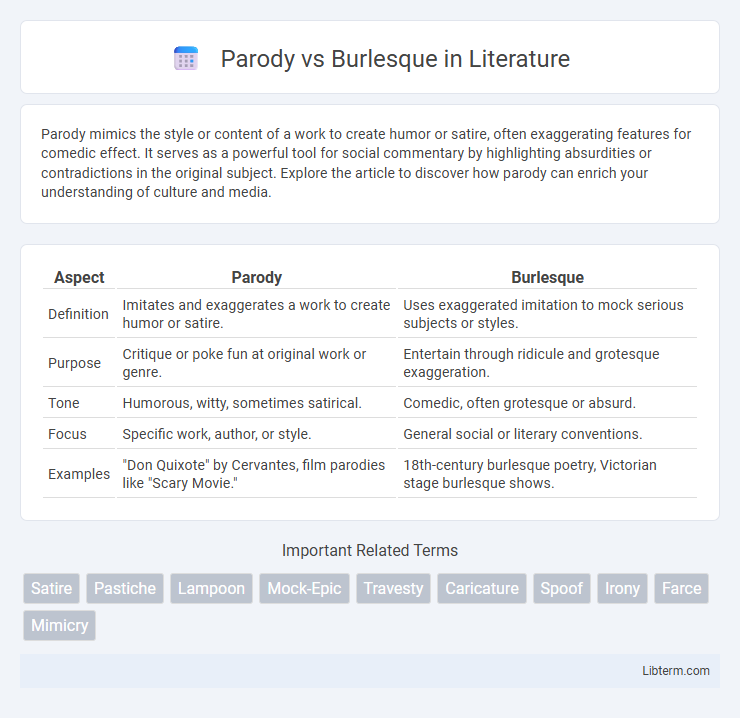Parody mimics the style or content of a work to create humor or satire, often exaggerating features for comedic effect. It serves as a powerful tool for social commentary by highlighting absurdities or contradictions in the original subject. Explore the article to discover how parody can enrich your understanding of culture and media.
Table of Comparison
| Aspect | Parody | Burlesque |
|---|---|---|
| Definition | Imitates and exaggerates a work to create humor or satire. | Uses exaggerated imitation to mock serious subjects or styles. |
| Purpose | Critique or poke fun at original work or genre. | Entertain through ridicule and grotesque exaggeration. |
| Tone | Humorous, witty, sometimes satirical. | Comedic, often grotesque or absurd. |
| Focus | Specific work, author, or style. | General social or literary conventions. |
| Examples | "Don Quixote" by Cervantes, film parodies like "Scary Movie." | 18th-century burlesque poetry, Victorian stage burlesque shows. |
Defining Parody and Burlesque
Parody imitates the style and content of a particular work or genre to create humor through exaggeration and satire, often targeting specific subjects or cultural phenomena. Burlesque uses exaggerated caricature and ludicrous imitation to provoke laughter, typically by transforming serious subjects into absurd or grotesque forms. Both forms rely on comedic distortion but differ in tone and intent, with parody focusing on intellectual mimicry and burlesque emphasizing physicality and spectacle.
Historical Origins of Parody and Burlesque
Parody emerged in ancient Greek literature as a form of satirical imitation designed to mock or comment on original works, with Aristophanes often cited as a pioneering figure. Burlesque originated in 17th-century Italy as a theatrical genre that exaggerated and distorted serious subjects for comedic effect, later evolving into a variety show blending humor, music, and dance in 19th-century America. Both forms historically serve to entertain by subverting expectations, but parody primarily targets literary and artistic works, while burlesque emphasizes performance and spectacle.
Key Characteristics of Parody
Parody primarily involves imitation of a specific work, style, or genre with deliberate exaggeration for humorous or satirical effect, often highlighting the original's flaws or absurdities. It relies on audience familiarity with the source material to deliver its critique or entertainment through irony and mimicry. This contrasts with burlesque, which employs broader comedic exaggeration and often incorporates performance elements like music and dance to mock or entertain.
Distinct Features of Burlesque
Burlesque is characterized by its theatrical exaggeration and satirical imitation, often employing comedy, music, and dance to mock or entertain through flamboyant performances. Unlike parody, which specifically mimics a particular work or genre to highlight flaws or humor, burlesque blends diverse elements of satire and spectacle, emphasizing visual spectacle and audience engagement. Key features include striptease acts, bold costumes, and a celebratory approach to sexuality and humor, distinguishing it as a performative art form with roots in 19th-century variety shows.
Purposes and Intentions Behind Each Style
Parody aims to humorously imitate and critique original works by exaggerating their distinctive features, often to provide social commentary or highlight absurdities. Burlesque focuses on entertainment through exaggerated theatricality, combining humor, dance, and satire to amuse audiences rather than directly critique specific works. Both styles utilize exaggeration but differ as parody targets particular subjects for commentary, while burlesque emphasizes broad comedic performance and spectacle.
Parody vs Burlesque: Tone and Approach
Parody employs humor through imitation, exaggerating specific traits of original works to create a comedic effect, often highlighting cultural or social critiques with a light-hearted tone. Burlesque, by contrast, uses grotesque exaggeration and absurdity to mock or ridicule, combining theatrical performance with satirical elements that can be both humorous and provocative. The tone of parody tends to be playful and witty, while burlesque embraces a more flamboyant and sometimes subversive style to engage audiences.
Famous Examples of Parody in Literature and Media
Parody in literature and media often mimics the style of a particular work or genre to create humor, with famous examples including "Don Quixote" by Miguel de Cervantes, which satirizes chivalric romances, and the film "Scary Movie," a parody of horror films like "Scream." Another notable parody is "Pride and Prejudice and Zombies" by Seth Grahame-Smith, which blends Jane Austen's classic novel with zombie fiction. These works showcase parody's ability to critique and entertain by exaggerating recognizable themes and stylistic elements.
Iconic Instances of Burlesque Performances
Iconic burlesque performances often showcase elaborate costumes, exaggerated movements, and humorous, risque themes that satirize societal norms and classical art forms. Notable examples include the works of Dita Von Teese, whose glamorous revivals of vintage burlesque have popularized the genre in modern times, and Gypsy Rose Lee, whose witty striptease routines in the early 20th century defined the art form's sophisticated humor. Burlesque's emphasis on theatricality and sensual parody distinguishes it from straightforward parody, blending comedy with dance and spectacle to critique culture with provocative flair.
Impact on Culture and Society
Parody influences culture by using satire to critique societal norms, often sparking conversations about politics, media, and pop culture through humor and mimicry. Burlesque, with its roots in theatrical exaggeration and sensual performance, challenges social conventions around sexuality and gender roles, encouraging liberation and self-expression. Both forms reshape cultural narratives, but parody emphasizes intellectual critique while burlesque emphasizes performative rebellion and body positivity.
Choosing the Right Approach: Parody or Burlesque
Choosing the right approach between parody and burlesque depends on the intended tone and target audience: parody uses humor and satire to imitate and critique specific works or genres, making it ideal for sharp, witty commentary. Burlesque employs exaggerated physical comedy and sensual performance elements to entertain through flamboyant spectacle and exaggeration. Understanding the purpose--whether to provoke thought through satire or to amuse with theatrical extravagance--guides creators in selecting the most effective style.
Parody Infographic

 libterm.com
libterm.com